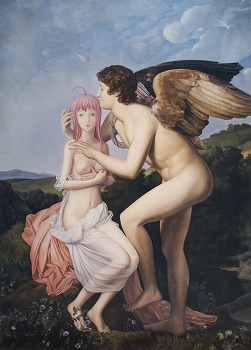 2010 7.23 - 8.7
2010 7.23 - 8.7

"ISHIGURO-YA"
Installation >>
*Opening Reception:
23rd July (Fri.)18:00 - 20:00
Akira Ishiguro “ISHIGURO-YA”
Venue: nca | nichido contemporary art
Date: 23rd July – 7th August, 2010
Gallery hours: Tue – Sat 11:00 - 19:00 / Closed on Sun, Mon and National Holidays
Reception: Friday 23rd July, 18:00 – 20:00
nca | nichido contemporary art is pleased to present an exhibition of works by Akira Ishiguro entitled “ISHIGURO-YA.”
Drawing his inspiration from classical paintings in the Western tradition, Ishiguro derives his aesthetic models from ancient Greek and Roman art, producing works that replace its traditional motifs and subjects with contemporary icons and lifestyles. The entire space of the installation that accompanies his paintings was also built entirely by Ishiguro himself. This exhibition showcases 10 of his most recent paintings along with this self-made installation.
A steganographic romance
The art of painting consists in the belief that an image depicted by the painterly brushstroke constitutes some kind of truth about the nature of beauty. Throughout the ages, we have come to regard the image that appears on the final, uppermost layer of the canvas as an icon of that faith, receiving and accepting this dispensation of truth.
Yet if the essence of painting resided in the laborious act of filling a canvas with countless brushstrokes so as to conceal the truth of that beauty within the depths of an abyss, where can we find the roots of this stranded beauty, so intimately entwined with the surface of the painting in question?
My first encounter with Akira Ishiguro’s painting was entirely fortuitous. Thrust at me without warning and leaving me disoriented, it took the form of a paradoxical question about the probability of acknowledging the existence of his brand of painting. Whatever the case, I felt instinctively that here was an artist who painted not in order to reveal some truth about the nature of beauty, but rather to suppress it.
Within the rigid, prescribed domain of the museum – a thick stone-walled fortress of self-proclaimed High Art – Ishiguro confronted the canon of classical Western paintings, earnestly scrutinizing each of them in order to learn how the masters depicted their chosen subjects. As if seeking to emulate them, he started making his own paintings in the same vein, populating them instead with the patron deities of Low Art: the beloved cartoon characters from animated films and video games who dared to infiltrate the foundations of High Art’s stronghold. What Ishiguro was seeking to do, of course, was not to try to resurrect these bewitching nymph-like beauties that he has depicted using classical methods. Rather, he invokes the goddesses and angels that inhabit the painting as a kind of icon whose function is to serve as an alibi and a pretext. The comical, often absurd tension that emerges as a result creates a forced layer of incongruity, guiding us towards a premonition of the truth that lies concealed beneath the ultra-thin canvas of the painting.
As strange as this approach may seem, Ishiguro’s art is based on one of the oldest models of steganography, from which modern forms of data encryption and hidden information are derived. Similar to the historical accounts of Herodotus, which describe how secret messages were written on the wooden backing of a tablet before being covered up with beeswax, Ishiguro’s paintings demonstrate the paradox of how it is precisely by being suppressed that a truth can be most strategically conveyed. The myriad of painted brushstrokes in his work are nothing more or less than a ruse that conceals the truth anew, rather than causing it to emerge.
Perhaps, then, what we required of our painters all along was the strength and courage to denounce the blind faith that glorified the depicted image, as well as their perseverance in continuing to suppress what had always been hidden from view. It is this power that Akira Ishiguro possesses: the power to overturn all the aesthetic values that reside peacefully in a world obssessed with superficial appearances, and to render that surface as vividly – and also as romantically – as possible.
Hiroshi Minamishima
Akira Ishiguro:
Born in Yokohama, Kanagawa in 1974.
Selected Exhibitions: “For Rent! For Talent! 5” Mitsubishi-Jisho ARTIUM (2009), “GEISAI#12” (2009), “GEISAI MUSEUM#2” (2008), “GIFT” Gallery LE DÉCO (2008), “Debli Project Art Tour”(2008), “Debli Project” (2007), “GEISAI#5-10” (2004-2006).
Hiroshi Minamishima:
Born in Nagano, Japan in 1957. Professor of Joshibi University of Art and Design since April 2008. After graduating from the School of Art and Design, University of Tsukuba, Mr. Minamishima was involved in the founding of several museums in Japan, including Iwaki City Art Museum and the Hiroshima City Museum of Contemporary Art. In 1993, he received a scholarship from the Fondation Cartier pour l’art contemporain and studied in Paris. From 2000, he worked for the establishment of the Contemporary Art Museum, Kumamoto (CAMK) and served as the founding director until 2008. He was also one of the co-curators of the International Triennale of Contemporary Art (ITCA) 2008 in Prague, and the commissioner of Japanese Pavilion of the 53rd Venice Biennale in 2009.